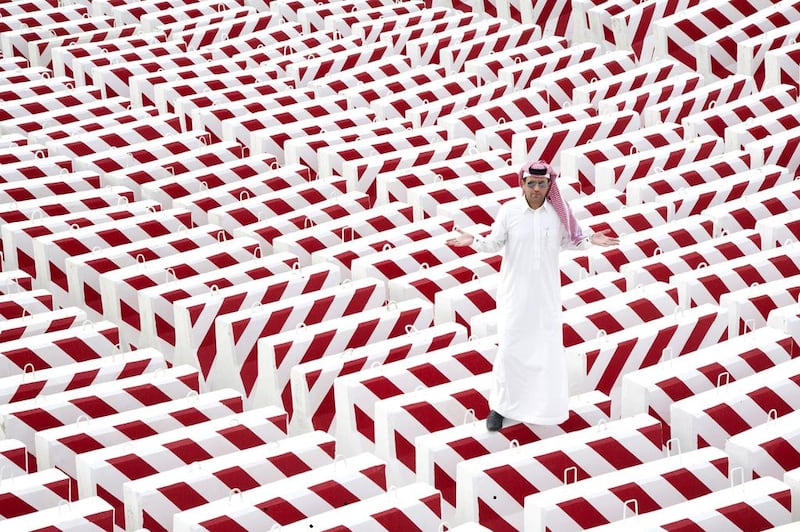Abdulnasser Gharem is considering the question that is at the very centre of his art. How does a lieutenant colonel in the Saudi army get to the point at which he is not only the highest-selling Arab artist, but famous for contemporary art that challenges the notions of authority and obedience?
“I know one thing,” he laughs. “There aren’t many artists who are trained to kill!”
Gharem – born in 1973 and, thankfully, incredibly gentle when we speak to him – is joking. As an artist, his is an incredible career path, one which took him from early watercolours to highly regarded public installations, inspired by his first access to the internet. “I was just sitting in front of a monitor for hours, looking at what other artists and galleries were doing,” he marvels. “And I found that painting was not enough to say what I wanted to say.”
But Gharem couldn’t give up the army – not least because, until recently, it was impossible to make a living as an artist in Saudi Arabia. So, rather than forcing ideological clashes with people more senior than him, he took the issues he came across in the region and broadened them to match global concerns. “For example,” he says, “one of my interests is the hypocrisy in Saudi. But there is hypocrisy everywhere in our world, no?”
So it’s apt that Gharem’s first major solo show is not in Saudi but London. On October 9, a career retrospective opens at the headquarters of the pioneering contemporary Arab art initiative Edge of Arabia. Included in the exhibition are some of Gharem’s most famous pieces, including Flora and Fauna, in which he wrapped himself and one of the trees lining the main street in the Saudi city of Abha in a sheet of plastic, as a comment on the environmental effect that rapid development is having on GCC countries.
Such public artworks have become Gharem’s stock-in-trade. He’s gathered 24 men to spray paint the word “siraat” – meaning “the path” – onto a collapsed bridge for four days and four nights. He’s used the concrete roadblocks present outside many official Western buildings to look at the issue of trust. And he sprayed “manzou” (meaning “about to be demolished”) across the houses of people who were living illegally on the border with Yemen.
“If you think about it, their situation is no different to people being forcibly moved on in Palestine, in parts of Africa, in China,” he says. “I’m not saying it’s right, but I’m trying to build a confidence among individuals in Saudi that what I’m doing and saying through art can open a discussion and negotiation. Which is why I like these public performance pieces – it’s a powerful medium where you find the real audience and you are right in the middle of society.”
Gharem, then, doesn’t shy away from controversy. His installation, the record-breaking Message/Messenger, which sold for US$842,500 (Dh3 million) in 2011, isn’t a traditionally aesthetic piece. Instead, it’s an admittedly beautiful golden dome, inscribed with “guide us to the right path”, rigged up to look like an animal trap and a comment on a post- September 11 world.
“9/11 changed a lot of things,” he says, and indeed two of the suicide bombers were in Gharem’s class at school. “No one can deny that there is a huge gap now between the new and old generations. But some use Islam as a trap and the kids jump in without thinking – no one trains them to think individually. They wait for someone to tell them what to do.
“Islam is a beautiful thing – which is why I wanted to make the dome so beautiful – but some people in conflict use it to justify their actions, which is just completely wrong. That piece was an overreaction maybe, but what I see going on around me is a lot of overreacting.”
And Gharem has seen a lot: he was unable to attend the opening night of his first exhibition in Dubai, for example, because he was busy commanding troops on the Yemeni border. But so deep is his belief that art can be a mechanism for change, that he gave all the proceeds from the sale of Message/Messenger to Edge of Arabia so it could bring Saudi artists to London for further education. Some of them exhibited in the recent Venice Biennale and Gharem has now set up his own Amen Art Foundation to run alongside Edge of Arabia, promising studios and courses for Saudi filmmakers, artists, photographers and sculptors.
“The talent is raw, it just needs someone to guide and direct it,” he says. “But we’re making a film in Riyadh, for example, and there are 25 people behind it. I think that sends out a message that, in the middle of the most conservative city in the world, you can do interesting things.
“Maybe some of these up-and-coming artists will be commercial, and that’s fine – but personally I resist those urges. You see, I’m not talking about developing artists who produce art and that’s it. I want them to develop into major players in our society.”
Overwhelmingly, then, the work of Gharem and his peers has provoked debate rather than outrage, which can only be a good thing.
“Exactly,” says Gharem. “The artwork is a platform to start talking.”
• The exhibition runs from October 9 to November 8 at Edge of Arabia, London, in partnership with Ayyam Gallery and Side by Side Gallery, Akim Monet. Visit www.abdulnassergharem.com for more details
artslife@thenational.ae





